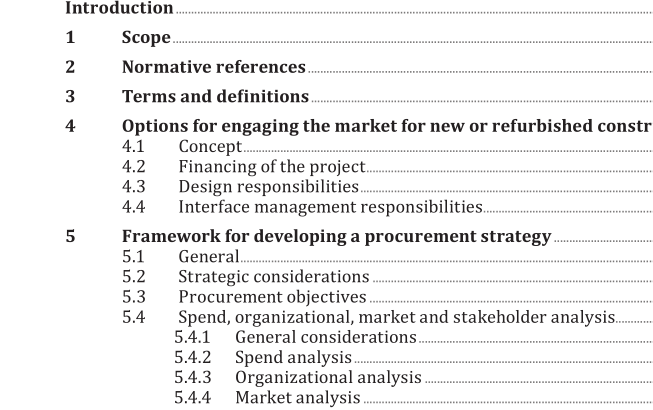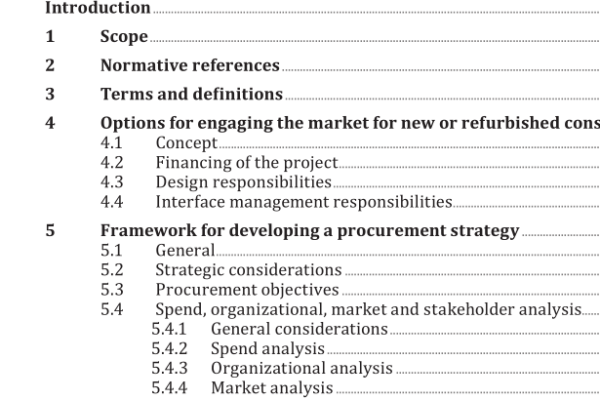ISO 22058:2022 pdf download – Construction procurement — Guidance on strategy and tactics.
1 Scope This document provides principles and requirements for safe handling, treatment and storage of solid recovered fuels (SRF), prepared from non-hazardous waste, to be used for energy purposes. This document covers process stages from point of acceptance of material to point of delivery of SRF. This document excludes fuels that are included in the scope of ISO/TC 238 Solid biofuels and ISO/TC 28 Petroleum products and related products of synthetic or biological origin. It uses a risk-based approach to determine what safety measures are to be considered. Although unloading and loading of e.g. vessels, trains or trucks are included, the safety issues following the loading and transport itself are not. 2 Normative references The following documents are referred to in the text in such a way that some or all of their content constitutes requirements of this document. For dated references, only the edition cited applies. For undated references, the latest edition of the referenced document (including any amendments) applies. ISO 12100, Safety of machinery — General principles for design — Risk assessment and risk reduction ISO 21637:2020, Solid recovered fuels — Terminology, definitions and descriptions 3 Terms and definitions For the purposes of this document, the terms and definitions given in ISO 21637:2020 and the following apply. ISO and IEC maintain terminological databases for use in standardization at the following addresses: — ISO Online browsing platform: available at https://www.iso .org/obp — IEC Electropedia: available at http://www.electropedia .org/ 3.1 Parts of the SRF process 3.1.1 baling process of producing a compressed material bundle or package secured by wires, hoops, cords or similar 3.1.2 belt conveyor conveyor with an endless belt acting as a carrying and traction element Note 1 to entry: There are several belt conveyor types, such as; troughed belt conveyor, deep troughed belt conveyor, pipe belt conveyor, walled belt conveyor, flat belt conveyor and radial conveyor.
3.2.3 risk analysis systematic use of available information to identify hazards and to estimate the risk (3.2.2) [SOURCE: ISO/IEC Guide 51:2014, 3.10] 3.2.4 risk assessment overall process comprising a risk analysis (3.2.3) and a risk evaluation ( 3.2.8 ) [SOURCE: ISO/IEC Guide 51:2014, 3.11] 3.2.5 risk control process of decision-making for managing and/or reducing risk (3.2.2); its implementation, enforcement and re-evaluation from time to time, using the results of risk assessment as one input 3.2.6 risk criteria terms of reference against which the significance of a risk (3.2.2) is evaluated Note 1 to entry: Risk criteria are based on organizational objectives, and external and internal context. Note 2 to entry: Risk criteria can be derived from standards, laws, policies and other requirements. [SOURCE: ISO/IEC Guide 73:2009, 3.3.1.3] 3.2.7 risk estimation process of assigning values to the probability of occurrence of events and their consequences [SOURCE: ISO 13824:2020, 3.15] 3.2.8 risk evaluation procedure based on the risk analysis (3.2.3) to determine whether tolerable risk (3.2.11) has been exceeded [SOURCE: ISO/IEC Guide 51:2014, 3.12] 3.2.9 risk management coordinated activities to direct and control an organization with regard to risk (3.2.2) [SOURCE: ISO/IEC Guide 73:2009, 2.1] 3.2.10 risk reduction measure protective measure action or means to eliminate hazards or reduce risks [SOURCE: ISO/IEC Guide 51:2014, 3.13 – modified: example has been removed.]
ISO 22058:2022 pdf download – Construction procurement — Guidance on strategy and tactics






